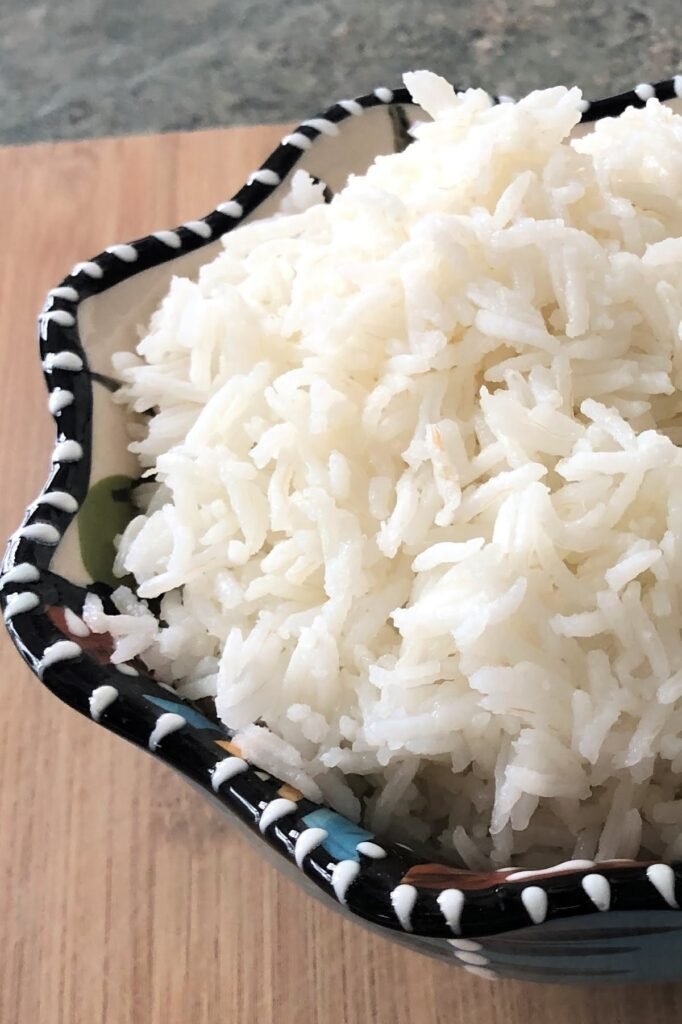They say variety is the spice of life, and when it comes to rice, I couldn’t agree more. In this article, I’ll be sharing my top 10 picks for the best types of rice that will give you that perfect, fluffy texture every time.
From fragrant Basmati to hearty Wild Rice, we’ll explore the characteristics and cooking methods that make each variety so special.
So, grab a spoon and get ready to elevate your rice game to a whole new level.

Basmati Rice
If you want fluffy rice, you should try using Basmati rice. I absolutely love cooking with Basmati rice because it always turns out light and fluffy.
The grains are long and slender, which allows them to absorb just the right amount of water while cooking. When I cook Basmati rice, I start by rinsing it thoroughly to remove any excess starch.
Then, I add the rice to a pot with water and a pinch of salt. I bring it to a boil, cover the pot, and let it simmer on low heat for about 15-20 minutes.
The result is perfectly cooked, fluffy rice with a delicate aroma and a slightly nutty flavor. Basmati rice is definitely my go-to choice for fluffy rice every time.
Jasmine Rice
Jasmine rice is known for its fragrant aroma and tender texture. It’s one of my favorite types of rice to cook with because it adds a wonderful flavor to any dish.
When I open a bag of jasmine rice, the smell instantly fills the kitchen, and it’s hard to resist taking a deep breath. The grains are long and slender, and they have a slightly sticky texture when cooked. This makes it perfect for dishes like stir-fries and fried rice.
I love how the grains clump together just enough to create a fluffy and light texture. Whether I’m making a simple side dish or a complex curry, jasmine rice always adds that extra touch of deliciousness.
Arborio Rice
When cooking with Arborio rice, you’ll notice its creamy texture and ability to absorb flavors.
As a fan of this Italian short-grain rice, I love how it transforms any dish into a luxurious and satisfying meal. Whether I’m making a traditional risotto or a creamy rice pudding, Arborio rice always delivers a rich and velvety consistency.
Its high starch content allows it to release starch while cooking, creating that desirable creamy texture. And the best part? Arborio rice has a remarkable ability to absorb the flavors of the ingredients it’s cooked with.
This makes it perfect for creating flavorful rice dishes that are bursting with taste. So, if you’re looking to elevate your next meal, give Arborio rice a try and experience its creamy and flavor-absorbing magic.
Carnaroli Rice
Carnaroli rice, known for its high starch content, creates a creamy texture when cooked and absorbs flavors beautifully. It is my go-to rice for making risotto.
The grains are short and plump, which allows them to absorb liquid without becoming mushy. When I cook Carnaroli rice, I can see the starch being released, creating a rich and velvety consistency. The creamy texture is perfect for dishes like mushroom risotto or seafood risotto.
Not only does it absorb flavors well, but Carnaroli rice also holds its shape during cooking, resulting in a dish with a nice bite. Its ability to retain moisture makes it ideal for slow-cooked dishes that require a longer cooking time.
Whenever I want a luxurious and creamy rice dish, Carnaroli rice is my top choice.
Sushi Rice
Sushi rice, also known as sticky rice, is essential for creating the perfect texture in sushi rolls. When I make sushi at home, I always reach for this type of rice. It has just the right amount of stickiness that holds the ingredients together without making the roll fall apart.
The grains of sushi rice are short and round, which allows them to absorb the flavors of the vinegar and other seasonings added to it. This results in a deliciously tangy taste that complements the fresh fish or vegetables used in sushi rolls.
The stickiness of sushi rice also helps in shaping the rolls and keeping them intact when slicing. Overall, sushi rice is a crucial component in achieving that authentic sushi experience.
Red Rice
If you’re looking to try something new, red rice is a nutritious and flavorful alternative to traditional white rice. I recently discovered red rice and I must say, it has quickly become one of my favorite grains to cook with.
The vibrant red color adds a beautiful pop to any dish, and the nutty flavor is simply delicious. Red rice is also packed with nutrients, including fiber, antioxidants, and minerals like iron and zinc. It has a slightly chewy texture, which adds a satisfying bite to meals.
Whether I’m making a stir-fry, pilaf, or salad, red rice always adds a unique and wholesome element to my dishes. Give it a try and you won’t be disappointed!
Black Rice
Alright, now let’s move on to black rice.
I’ve always been intrigued by its unique appearance and nutty flavor. Black rice, also known as forbidden rice, is a type of whole grain that originated in Asia. It has a striking dark color due to its high concentration of anthocyanin, a powerful antioxidant.
Not only does black rice add a pop of color to your plate, but it also packs a nutritional punch. It is rich in fiber, vitamins, and minerals. When cooked, black rice has a slightly sticky texture and a slightly sweet taste. It pairs well with both savory and sweet dishes, making it a versatile choice.
If you’re looking to add a touch of elegance to your meals, black rice is definitely worth a try.
Brown Rice
To make brown rice, simply follow the same cooking process as white rice, but with a longer cooking time.
Start by rinsing the rice to remove excess starch.
Add the rice to a pot with the appropriate amount of water.
Bring it to a boil, then reduce the heat to low and cover the pot.
Let the rice simmer for about 45 minutes, or until all the water is absorbed and the rice is tender.
It may take a bit longer than white rice, but the end result is worth it.
Brown rice has a nutty flavor and a slightly chewy texture that adds depth to any dish.
Wild Rice
When cooking wild rice, you’ll want to start by rinsing it to remove any impurities and excess starch. This step is important because it helps to ensure that the rice cooks evenly and has a nice texture.
To rinse the wild rice, simply place it in a colander and run cold water over it for a few minutes, stirring it gently with your hands.
Once the rice is rinsed, you can proceed with cooking it.
Wild rice has a unique nutty flavor and a slightly chewy texture, making it a great addition to various dishes like salads, soups, and stir-fries. It pairs well with vegetables, meats, and even fruits, adding a delicious and nutritious element to your meals.
Forbidden Rice
Now, let’s move on to another type of rice that I absolutely love: Forbidden Rice.
This unique rice variety has a deep, rich black color that turns into a beautiful purple hue when cooked.
I have to say, it adds a stunning visual appeal to any dish!
But it’s not just about the looks – Forbidden Rice also has a delicious nutty flavor and a slightly chewy texture.
It’s packed with antioxidants, fiber, and nutrients, making it a wholesome choice for any meal.
Whether I’m enjoying it in a stir-fry, a salad, or even as a dessert, Forbidden Rice always brings a touch of elegance and a burst of flavor to my plate.
Jenny has always been passionate about cooking, and she uses her platform to share her joy of food with others. Her recipes are easy to follow, and she loves giving tips and tricks to help others create their own unique culinary creations.

